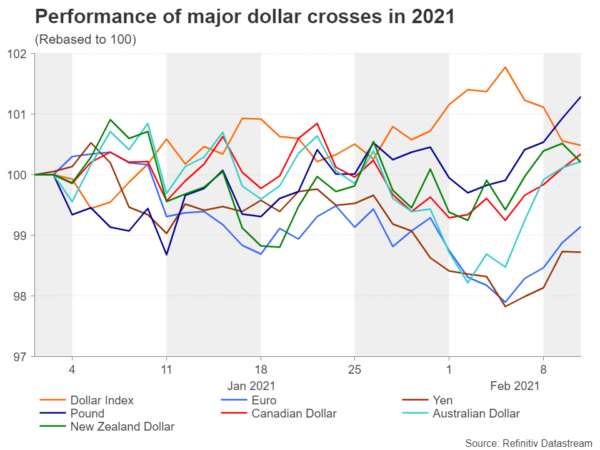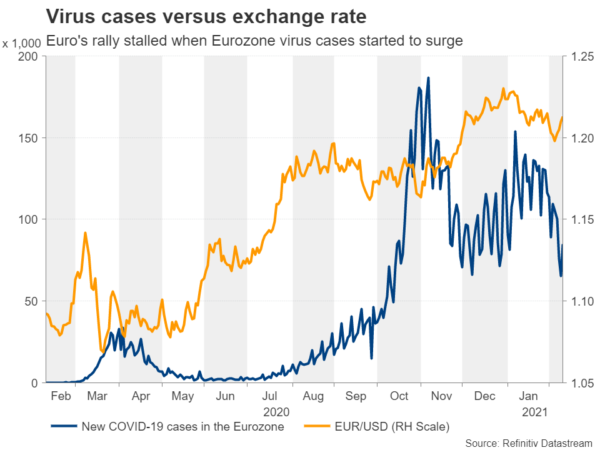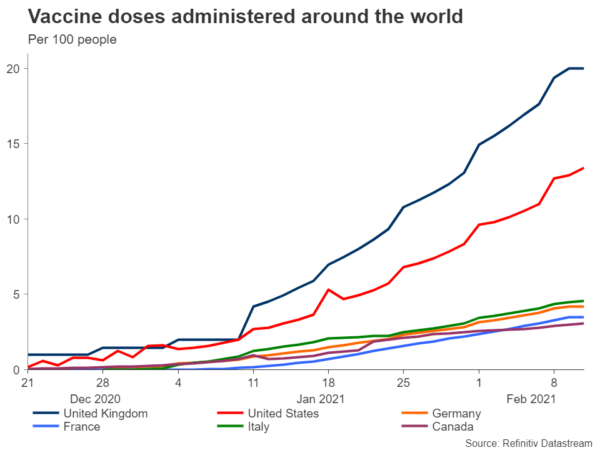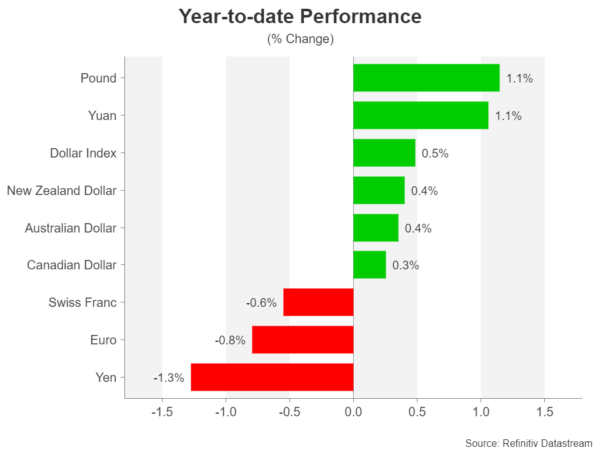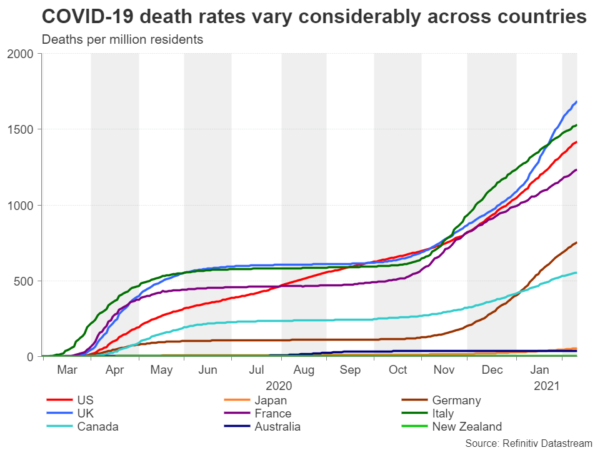The global campaign to vaccinate people against Covid-19 began in earnest in December, marking a historic milestone in the fight to bring an end to the pandemic. However, as governments scramble to get their hands on a limited supply of Covid vaccines, the disparity in the immunization rate between different nations is not going unnoticed in the FX world. Countries that are pulling out all the stops to vaccinate their population are seeing comparative strength in their currencies, whilst those lagging behind are losing the confidence of investors.
It’s all about the Fed and stimulus
There can be no doubt that the US stimulus narrative and speculation about when the Federal Reserve will begin to taper its asset purchases are the main fixations of market participants right now. As the US dollar becomes less of a safe haven play as the virus turmoil gradually subsides, economic fundamentals are taking centre stage again.
With the US economy set to outperform its rivals in 2021, the bearish bets made against the dollar on the back of the unwinding of safe-haven trades seem to have been overdone. But even in this corrective phase, there have been winners and losers among the major dollar crosses. So what’s setting these currencies apart?
Are health metrics the new economic data?
The last year has shown us that during a global pandemic, economic indicators are not the only data investors care about. Health data have become a key gauge on a nation’s economic prosperity ever since it transpired that lockdowns are the only way to control the spread of the coronavirus. Up until vaccines were ready to be rolled out, it was a country’s infection rate that investors were watching to guide them about the outlook. But now that vaccines are in the picture, it is the pace of immunization that is the new focus as they are seen as the only way out of this pandemic.
The sooner enough people have been vaccinated to achieve herd immunity (this is put at between 70% to 80% of the population by most estimates), the sooner an economy can fully reopen. Although, even in the best-case scenario, some restrictions will still likely be needed, it would nevertheless symbolise the end of hard lockdowns.
The West’s questionable pandemic response
One thing that has unmistakably emerged over the past year is that some countries have done a better job than others in keeping the virus under wraps. In Europe and America, the national responses have been uncoordinated, contradictory and not reactive enough.
The United Kingdom is probably the worst offender in this category, with Boris Johnson’s government being the most reluctant to get tough. However, one thing Johnson did get right was to start planning for the vaccine rollout long before others did. It’s no coincidence therefore that the UK was the first country to approve the Pfizer/BioNTech vaccine and the first to begin inoculating in the Western world.
UK leads the vaccination race
More than 13 million people have now received their first dose in the UK, putting it ahead of all other big nations. The government is aiming to have vaccinated everyone over the age of 50 by May, meaning there could be a significant relaxation of Covid rules by the summer. The target for all adults is September and if all goes according to plan, business shutdowns could become a thing of the past before the year-end.
In contrast, the European Union has been accused of being too late in the game to place vaccine orders for its member states, leading to delays in shipments to the bloc. Large EU states have vaccinated less than 5 per 100 people, whereas 20 in every 100 people have received their first jab in Britain. At the current rate, the EU’s target to immunize 70% of all adults by September is probably unachievable, making it difficult for governments to lift their virus curbs too substantially.
In America, containment measures and consequently, infection levels vary considerably across states. But like the UK, the US moved quickly in approving and ordering vaccines and the rollout has gathered even more speed under the new Biden administration. The US is also going out in full force with fiscal stimulus, almost guaranteeing a full recovery before anyone else.
Pound top of the FX pack
Unsurprisingly, these are the economies that investors have turned most optimistic about in 2021, pushing their currencies higher. The pound is the best performing major so far against the US dollar this year, surging above $1.38 to near three-year highs. Receding expectations that the Bank of England will cut rates to negative have provided an additional nudge up. The greenback, meanwhile, has gained around 0.5% against a basket of currencies and has been rallying versus its safe-haven peer, the Japanese yen.
The euro, however, is down about 0.75% in the year-to-date, as investors have lost faith in the EU’s ability to sort out its vaccine mess. In addition, there’s little prospect of the euro area receiving another EU-level virus recovery fund. Thus, Europe looks set to lag the US and UK in recovering from the pandemic slump.
The lucky few
But what about the countries that have been more successful in keeping their virus cases low? Australia, Japan and New Zealand have one of the lowest Covid death rates in the world. The economies of Australia and New Zealand are largely open now due to their governments imposing lockdowns swiftly as soon as new clusters are discovered, while Japan has avoided lockdowns altogether. This could explain why these countries aren’t in as much rush to jump ahead in the vaccination race.
Yet, the Australian and New Zealand dollars are the next best performers after sterling. That is because their economies were always expected to make a strong rebound with or without vaccines. Japan is also in the same boat, though the yen’s fully fledged haven status implies its currency won’t behave in a similar fashion.
The odd one out has to be the Canadian dollar, as it’s up almost 0.4% year-to-date versus the greenback even though Canada is in a similar predicament to the Eurozone, both in terms of infections and with the pace of vaccinations. Higher oil prices are probably one reason why the loonie remains bullish. But another and more powerful factor is the brightening outlook for Canada’s closest trading partner – the United States.
Will inflation rear its ugly head?
If the American economy does indeed come out the strongest from the pandemic, then even the commodity-linked dollars might start to struggle against the US currency, as the Fed would be forced to tighten monetary policy far sooner than other central banks. However, a lot depends on what happens to inflation. A modest pickup in inflation, say to around 3%, is more likely to harm the US dollar as this is a level the Fed has indicated it’s willing to tolerate, hence allowing real rates to fall. Unless there’s a sharper rise in inflation, the Fed won’t budge, so the downside risks to the dollar are far from dead.
Blurry outlook
Even for sterling, the outlook is blurry as vaccines are just about the only thing supporting it, making it extremely vulnerable to any negative developments such as new dangerous virus strains. Investors also appear to be underestimating the danger of a trade confrontation between the UK and EU following the bad Brexit deal. The Sino-US trade war is not over either, and Australia and New Zealand seem to be headed towards a conflict with China too.
All this suggests that while the vaccine headlines will continue to drive FX markets over the next few months, risks around inflation, new Covid variants and trade tensions should not be ignored. That’s not to say, though, that the latest trends won’t have enough legs to last through the end of the year.




